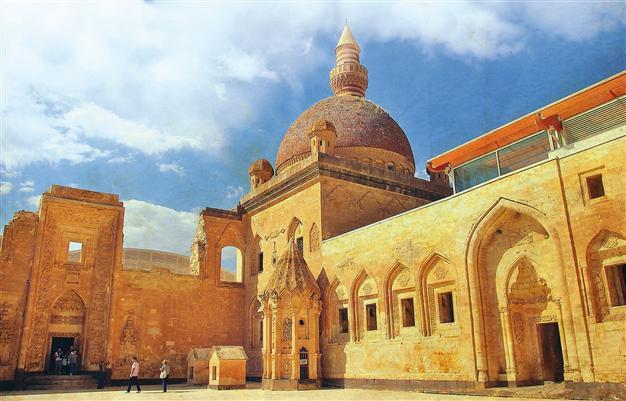İshak Paşa Palace attracting visitors anew with restorations
AĞRI - Anatolia News Agency

With the new restoration period, İshak Paşa Palace is looking to attract even more visitors with the completion of restoration work on the facility’s original grain silos.
One of Turkey’s most awe-inspiring sites, İshak Paşa Palace near the border with Iran, is looking to attract even more visitors with the completion of restoration work on the facility’s original grain silos.
“These places are made to keep the food fresh; that’s why the [depot] is very cool and dry,” Anatolia news agency quoted Ağrı Culture and Tourism Manager Muhsin Bulut as saying Oct. 14.
The depots were closed for many years but are now being reopened to the public following extensive restoration work.
Bulut said the building’s walls had displayed numerous cracks due to misguided attempts to conduct restoration in the past, adding that the team turned its attention to the grain depots following the most critical refurbishments, which were conducted between 2010 and 2012.
Located in the eastern province of Ağrı’s Doğubeyazıt district, İşhak Paşa Palace was an Ottoman-period facility whose construction was begun in 1685 by Çolak Abdi Paşa. Construction of the sandstone-colored building was continued by his son İshak Paşa before it was finally completed by one of his grandsons, Mehmet Paşa. The harem section, however, was completed by İshak Paşa in 1784, according to an inscription above its door.
Like Istanbul’s famous Topkapı Palace, İshak Paşa served as a major administrative center in addition to being a palace.
Bulut also claimed the palace was the first building in the world to utilize a heating system.
Preparing the way for night visitsİshak Paşa is currently on UNESCO’s temporary cultural heritage list although Turkish cultural authorities are working to ensure that it soon enters the permanent list, Bulut said, adding that the palace was not only a piece of heritage for Ağrı or Turkey but for the whole world.
“We are now considering starting to work on developing the palace’s visual qualities and beauty. After the new works are completed, the palace will be available for night walks and night visits,” the cultural official said.
Rain and snow will no longer harm the palace thanks to a protective cover on the palace’s façade, Bulut said, adding that such a step was crucial in bequeathing the palace to future generations.
Apart from the palace’s first and second courtyards, all areas of the palace have been covered with the façade, he said, adding that the protective glass sheeting was removable.
Effects of TV seriesTourist numbers at the palace have increased in recent years particularly due to the growth of historical television series that depict the facility’s harem, he said, adding that many tourists coming to the palace would also like to see the room of İshak Paşa.
The palace is located on a valley slope that is extremely rocky and hard. Although it was situated in the middle of the former center of Beyazıt, three of the facility’s sides – to the north, west and south – are steep and sloped, meaning that the only suitable, flat area for the palace was on the east. As such, the palace’s builders made the entrance to the facility on that side, decorating it with stone workmanship and carving.
In terms of defense, however, the castle was rather weak due to the inability of the palace’s inhabitants to protect themselves against assailants using firearms on the eastern side.
